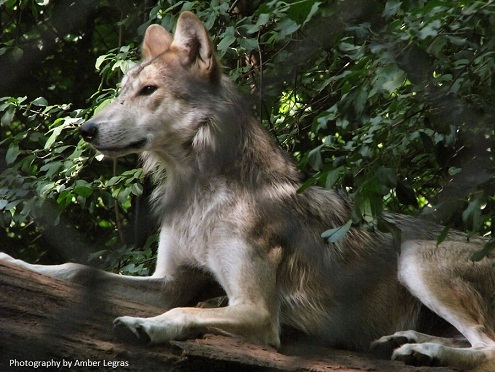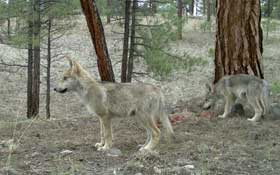In the News: A Mexican gray wolf will be captured alive from the Gila National Forest
 By Susan Dunlap
By Susan Dunlap
SILVER CITY – The Department of Fish and Wildlife Services put out an order on Feb. 12 to capture an uncollared Mexican gray wolf in the area where the Fox Mountain Pack roams, south of Quemodo near Fox Mountain in the Gila National Forest. The reason for the live capture of this endangered species is because of five reported livestock deaths within the past year.
“They’re not likely to catch the animal that did the killing,” said Michael Robinson, conservation advocate for the Center for Biological Diversity. “This is an imprecise way of addressing livestock [depredation].”
The U.S. Department of Fish and Wildlife Services disagree.
“Because wolves feed and kill as a pack, it is often difficult to distinguish which individual wolves are involved in the depredation,” Maggie Dwire, assistant Mexican wolf recovery coordinator for the U.S. Fish and Wildlife Service said through an email. “Given the background of the Fox Mountain Pack, we assume that all wolves within the pack may have been involved in depredations in the past.”
Dwire insisted that though it is difficult to determine the individual wolf involved, the Fish and Wildlife Service is committed to protecting the Mexican gray wolf species.
“The removal effort combined with continued use of non-removal tools is designed to prevent or limit additional depredations,” Dwire said. “We conduct a stepwise approach and first attempt to reduce depredations by non-removal tools, followed by removal of individuals most likely to be involved in the depredations. Following the removal of an individual, we monitor the pack and continue non-removal tools in an effort to prevent additional depredations. If additional depredations occur, we will reassess our strategies, not because we removed the wrong animal, but rather because we have not solved the depredation problem and have not yet achieved the right combination of actions to limit additional depredations by the pack.”
The Mexican gray wolf is a sensitive issue involving tradition, economics and the fate of a species. Ranchers are allowed to let their cattle roam in forested areas owned by the Bureau of Land Management (BLM) and the state of New Mexico, according to Cliff resident Brandi McCauley, whose family has been ranching in the Cliff area for 104 years. According to BLM’s website, ranchers must pay a fee to allow their livestock to roam BLM land, though the fee fluctuates depending on market conditions for beef and other factors.
Any livestock deprivation has an economic impact on ranchers, first because they pay to let their cattle graze public land and then they experience a financial loss if they lose their livestock. But Robinson pointed out, ranchers are compensated for livestock deprivation if a wolf is the cause. “¦
“Cattle have been roaming this country for a long time,” McCauley said.
This makes livestock vulnerable to attacks by wildlife predators.
The Mexican gray wolf’s population has been brought to record lows. They were successfully poisoned, trapped, clubbed and shot until they were almost completely annihilated by the mid-1900s according to the U.S. Fish and Wildlife Services’ website. Their natural habitat encompasses southern New Mexico, among other areas of the western United States.
The Mexican gray wolf was listed under the endangered species list in 1976, according to the Fish and Wildlife Services Department. But recovery of this particular animal has been slow.
The only other wildlife to have hit such low numbers and recovered in the wild with at least a moderate level of success are the black-footed ferret and the California condor, according to Robinson. There are only 83 reported Mexican gray wolves in the wild, according to a recent survey conducted by the U.S. Fish and Wildlife Service. That means that every single wolf in the wild is important for breeding purposes if the animal is to recover, according to Robinson.
“There is a genetic crisis in the Mexican gray wolf,” Robinson said. “Because there are so few of them, their breeding has been slowed down and is near cessation.”
Dwire said the Fish and Wildlife Service won’t know how genetically important the uncollared Mexican gray wolf will be until the wolf is captured and tested, but she said that if the captured wolf contains lineage of one of the three founding lineages, that lineage is represented by the captured wolf’s siblings, sires, and other members of the wolf population.
Dwire also said the department will evaluate the potential for whether the animal will be re-released in the U.S. or Mexico some time in the future or if the animal will become part of what she described as a captive breeding program.
“It’s a tough balancing point,” Dwire admitted.
Susan Dunlap can be reached at 575-538-5893 ext. 5803.
To read the full article, published in the Silver City Sun-News, click here.
************************************************************************************************************************************* Please act today to keep the young Mexican wolf the government is targeting for removal in the wild where he belongs!
Please act today to keep the young Mexican wolf the government is targeting for removal in the wild where he belongs!
Calls and emails to decision-makers are needed. Talking points and contact information are here.
You can also help by writing a letter to the editor thanking the Silver City Sun-News for the article and supporting Mexican wolf recovery.
Tips and talking points for writing your letter are below, but please write in your own words, from your own experience.
Letter Writing Tips & Talking Points
- Mexican gray wolves are beautiful, intelligent, native animals. We have a responsibility to them and to future generations to ensure their recovery.
- At last count, just 83 wolves including 5 breeding pairs survived in the wild.
- The government should not be targeting critically endangered wolves, who may be very valuable genetically, for permanent removal.
- Removing a wolf at random may break up a potential breeding pair and will place him/her and all of the wolves nearby at risk, since capture carries a high risk of accidental death or injury.
- This perpetuates a failed policy of scapegoating wolves who occasionally prey on livestock — even when the stock-owner is reimbursed.
- If the US Fish and Wildlife Service is concerned about the growth of the population and its genetic health, the answer is more releases of captive wolves, not subjecting more wild wolves to risky trapping operations and permanent captivity.
- Moving Mexican gray wolves closer to extinction is not the solution to livestock conflicts.
- Livestock businesses on public lands are reimbursed for losses and can receive government and non-profit assistance for non-lethal proactive measures to avoid depredation. They have a responsibility to implement such measures.
Make sure you:
- Thank the paper for publishing the article.
- Do not repeat any negative messages from the article, such as “cows may have been killed by wolves, but”¦” Remember that those reading your letter will not be looking at the article it responds to, so this is an opportunity to get out positive messages about wolf recovery rather than to argue with the original article.
- Keep your letter brief, between 150-300 words.
- Include something about who you are and why you care: E.g. “I am a mother, outdoors person, teacher, business owner, scientific, religious, etc.”
- Provide your name, address, phone number and address. The paper won’t publish these, but they want to know you are who you say you are.
- Submit your letter here: editor@scsun-news.com
____________________________________________________________________________________________________________________________________
Click here to join our email list for Mexican gray wolf updates and action alerts.
Visit us on Facebook here.



